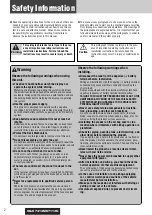
Reverse Voice Over
Description
While on a handset call, Reverse Voice Over lets a busy Multiline Terminal user make a private
Intercom call to an idle co-worker. The idle co-worker can be at a Multiline Terminal or Single Line
Terminal. The busy user just presses and holds down a programmed Reverse Voice Over key to make
a private call to a specified co-worker. The initial caller cannot hear the Reverse Voice Over
conversation. The private Intercom call continues until the Reverse Voice Over caller releases the key
again. The initial call can be an outside call or an Intercom call.
Reverse Voice Over could help a salesman, for example, when placing a call to an important client.
The salesman can talk with the client and give special instructions to a secretary - without interrupting
the initial call.
When the Multiline Terminal is idle, the Reverse Voice Over key functions the same as a Hotline or
One-Touch key. A Multiline Terminal Reverse Voice Over key also shows at a glance the status of the
associated extension:
When the key is. . .
The associated extension is. . .
Off
Idle
On
Busy or call ringing
Fast Flash
In Do Not Disturb
When the destination extension is idle, the Reverse Voice Over provides one button calling to the
associated extension (like a Hotline key). An extension user cannot, however, use the Reverse Voice Over
key to Transfer calls by one-touch operation.
Conditions
• This feature is available for 2W Digital/IP Multiline Terminal Only.
• An extension can have Reverse Voice Over keys for more than one extension (limited only by the
number of available function keys).
• When the destination extension is in Do Not Disturb, a Reverse Voice Over placed to an extension
always rings, regardless of how Handsfree Answerback/Forced Intercom Ringing is set at the
destination.
• When the destination extension is not in Do Not Disturb, Reverse Voice Over follows Handsfree
Answerback/Forced Intercom Ringing programming.
• Reverse Voice Over requires a uniquely programmed function key.
• Reverse Voice Over is not available from Single Line Terminals, but a single line can be a Reverse
Voice Over destination.
• If an extension user places a Reverse Voice Over to a busy destination extension, the system sets
up a Voice Over. The Voice Over continues until the Reverse Voice Over key is pressed again.
• When a Reverse Voice Over call is placed to a destination station, while the originator is on a CO
call, the Reverse Voice Over is dropped if the destination station is involved in another call and this
call is terminated.
Default Settings
Disabled
None
ISSUE 1.0
SL2100
Features and Specifications Manual
1-725
R
Summary of Contents for UNIVERGE SL2100
Page 1: ...Features and Specifications Manual GVT 010794 401 00 AU ISSUE 1 0 May 2017 ...
Page 14: ...MEMO SL2100 ISSUE 1 0 R 4 Regulatory ...
Page 313: ...Operation None ISSUE 1 0 SL2100 Features and Specifications Manual 1 299 D ...
Page 412: ...Operation None SL2100 ISSUE 1 0 1 398 Howler Tone Service H ...
Page 572: ...LCR Dial LCR Dial Editing SL2100 ISSUE 1 0 1 558 LCR Least Cost Routing L ...
Page 573: ...LCR Cost Center Code ISSUE 1 0 SL2100 Features and Specifications Manual 1 559 L ...
Page 846: ...2 Press Hold key and talk with the party SL2100 ISSUE 1 0 1 832 Tone Override T ...
Page 878: ...Operation None SL2100 ISSUE 1 0 1 864 Universal Slots U ...
Page 946: ...MEMO SL2100 ISSUE 1 0 1 932 Warning Tone for Long Conversation W ...
Page 976: ...MEMO SL2100 ISSUE 1 0 3 6 Features Availability by Software Revision ...
Page 977: ...MEMO ISSUE 1 0 SL2100 Features and Specifications Manual 3 7 ...
Page 978: ...Features and Specifications Manual NEC Corporation ISSUE 1 0 ...
















































